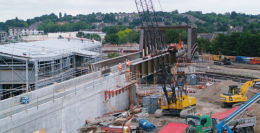Posted 1st September 2008 | No Comments
New for old as £billion-plus upgrades start to take shape

The new flyover will take the East London route over the East Croydon main line. Picture: Phil Caley
From the Central Belt of Scotland to rural Lincolnshire and south London, engineers working for Network Rail and Transport for London are carrying out some of the biggest rail enhancement projects on the national network.
David Ewart reports on some of the everyday problems being faced, and solved, by the men and women in hard hats charged with updating the rail system.
LIZARDS needing a new home, mating foxes and a Japanese knotweed infestation are three of the more unusual problems tackled on the £1.4 billion East London Line project.
Transport for London and its contractor Balfour Beatty were confronted with the wildlife snags during construction of a self-contained train maintenance depot for the East London Line Extension project at New Cross Gate, south-east London.
The upgraded former London Underground line between New Cross, Whitechapel and Shoreditch will be linked to the North London line at Dalston Junction and to the London Bridge to Crystal Palace and West Croydon route at New Cross Gate in a project to be completed in 2010.
This will enable a new fleet of four-car dual-voltage EMUs to run between Highbury and Islington and West Croydon, and further extension could eventually link it to Clapham Junction as well.
In the words of Transport for London’s construction manager Maurice Alexander, the challenge of working on a constricted site hemmed in by a main line railway and industrial and residential development has been like “getting a quart into a pint pot”.
Before work could begin to rebuild three local bridges and crane-in a new rail flyover crossing the London Bridge to East Croydon main line, 50 protected lizards had to be re-homed and tons of Japanese knotweed cleared and consigned to the local industrial incinerator.
“We’ve been careful to minimise noise for local residents, but reported high pitched squealing from the site at dead of night turned out to be mating foxes,” Maurice said.
“Also, environmental protection has been given priority with high-spec insulation of depot buildings and noise barriers alongside depot tracks, and harvesting of rainwater from building roofs to wash the trains.”
Meanwhile, at Lincoln station, phase two of a £55 million project to renew and upgrade track and signalling has been completed by Network Rail and its contractors.
But it has not been without complexities – engineers have had to negotiate underground water tracking as well as a team of archaeologists safeguarding an ancient monument.
The six-week closure, which turned the station into a hub of intensive bus replacement operations and shut the busy High Street to traffic, has replaced semaphore signal-ling and its four manual boxes with a state-of-the-art computerised control centre for 48 LED colour-light signals and axle counters.
It has also renewed 22 switches and crossings as well as plain track, and upgraded the busy High Street level crossing with CCTV.
In charge of the work were Network Rail’s senior project engineer Darin Gray and project manager Ben Lynch.
“Installation of large signal gantries at each end of the station were 14-hour jobs, which called for meticulous planning,” said Ben.
“One had to be sited over a culverted stream that dog-legged beneath the track, so we had to carry out exploratory drilling to determine its course and safe standing for our heavy crane.”
At the other end of the station, archaeologists were cal-led in to help safeguard an ancient monument in a lineside church while a heavy crane lifted in the second gantry.
The new VDU-based control centre, which has in-built capacity to link with a much larger area if required, incorporates a signalling control training module, only the second of its kind in the country.
“We have trained all our Lincoln area signallers in the new technology by programming the equipment to simulate every operating condition, so even other signalling areas around the country can be replicated if needed,” explained Darin.
Drivers working through the renewed area have been given comprehensive virtual reality DVDs to help them with route familiarisation.
Throughout the project, the team has liaised closely with Lincolnshire County Council Highways, which has resurfaced the road to match new decking on the High Street level crossing.
The Lincoln station area will now benefit from vastly improved operating flexibility, with bi-directional working and line speed raised from 25 to 35mph. The new axle counter-based signalling is expected to bring greater reliability.
And there are other long-term benefits – such as the direct East Midlands Trains service to St Pancras International from the end of the year, which the upgrade work has made possible.
